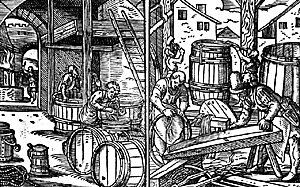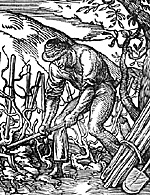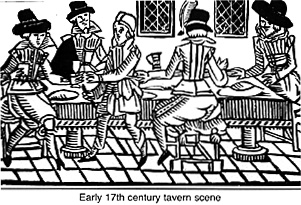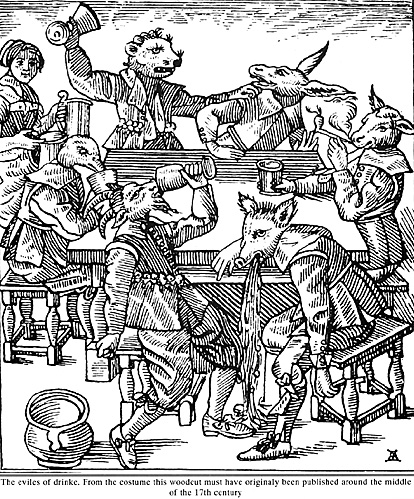If all be true that I do think
There are five reasons we should drink
Good wine - a friend - or being dry -
Or lest we should be by and by
Or any other reason why
By way of introduction, this article aims to define certain terms that we inevitably come across whilst researching the period of the English Civil Wars. It was written in response to an enquiry about Rhenish wine, which is constantly referred to in cookbooks of the time.
Rhenish wine is wine produced in the Rhine district, on the banks of that river, if you want to be specific. Rhenish wine commenced to be known as Hock from the l8th Century, and refers to whites. The area is famed for its Rieslings. Other terms you might find in historic texts for the wines of this area are rinois (french), rinisch (german) and Rijnsch (dutch). And yes, they are all variants of the one word.
Hock is a term for German white wine (also known as Hochheimer and Hockamore!) named after Hochheim (the place). Sadly, the word has become slanted (by colonial types) to mean any local dry white wine, good or bad. Roger Ascham (1515-68) writes: "And surely this wine of Rhene is so good, so natural, so temperate, so ever like itself as can be wished for man's use. I was afraid when I came out of England to miss beer; but I am more afraid that when I shall come into England that I cannot lack this wine."
There are countless English 17th Century odes to Sack. All lengthy and some quite passionate. That fellow Shakespeare also had much to say about it. From Henry IV, "A good Sherris-Sack hath a two-fold operation in it; it ascends me into the brain; dries me there all the foolish, and dull, and crudy vapours which environ it, makes it apprehensive, quick, inventive, full of nimble, fiery and delectable shape, which delivered o'er to the voice which is the birth, becomes excellent wit. The second property of your excellent Sherris is the warming of the blood; which before cold and settled left the liver white and pale, which is the badge of pusillanimity and cowardice; but the Sherris warms it, and makes it course from the inwards to the parts extreme." He was obviously drunk when he wrote this.
The Canary Islands, Spanish Atlantic outposts, were a once respected source of wines. Canary sack was a very well thought of wine from the 16th Century until the 19th, when a nasty scourge (a fungal disease) wiped out the vineyards. It never quite got on its feet again, though a small quantity of sweet wine is still produced. From all accounts, Canary was a superb dessert wine.
Shakespeare refers to it in King Henry IV - "you have drunk too much canaries, and that's a marvellous searching wine..."
Speaking of which, Bristol Milk is another (general) term for sherry, although it probably also referred to a type of rum punch. Pepys writes about it in 1688. .... did give us a good entertainment of strawberries, a whole venison pasty, cold, and plenty of brave wine and above all Bristol Milk." Thomas Fuller (1608 - 91) writes in his Worthies of England, "This metaphorical milk, whereby Xeres of Sherry Sack is intended." Defoe (1660-1731) even confirms that Bristol milk is Spanish sherry.
Madeira (from Madeira, my dear .. ) was made by the Portuguese, who settled there in the fifteenth century and established their vineyards after torching the native forests that covered the island. It is a fortified wine, though not all sweet as is generally thought. There are three types: sercial (dry), verdelho (medium) and bual, (sweet - also known as malmsey). It is said that Madeira is not worth drinking until it has "crossed the line" (the equator) as it improves with heating. Consequently it was often used as the ballast for ships. This was popular, for if the vessel found itself in trouble, one could drink the ballast. Thus, seemingly averting catastrophe. The Duke of Clarence reputedly drowned in a butt (cask of up to 126 gallons) of malmsey during the fifteenth century, although this is very unlikely as it wasn't known in England then.
Cider is a venerable beverage well known in cold climates, where it is easier for apples to grow than vines.
Perry is a comparable beverage made from pears. For some unknown reason it never made it big in the English speaking world. Alas!
Brandy came into use during the Seventeenth Century as Brandwine. This referred to any potable spirit from any source. ie. The spirit distilled from wine, be it grape or another fermented fruit juice. Cognac (a pure grape brandy) was known in 1643, under the brand name of Augier. Armagnac (also a grape brandy of outstanding quality) was said to be the favourite tipple of d'Artagnan.
Claret is constantly referred to by both Pepys and Evelyn in the seventeenth century, and was highly regarded. It is documented that British Firms were established in Oporto (home of port) Portugal, as early as 1638.
The enigmatic beverage, Banque, was described by J. Howell in 1634 as a drink "rare and precious of the oriental countries such as Cambaia and Calicut..." The mind boggles...
The Eviles of Drinke (mid-17th century).
 My chief reference is a book called "The Dictionary of Drink and Drinking" written by that excellent Melbournian, Oscar A Mendelsohn in 1965. (Macmillan & Co.) He also wrote "Drinking with Pepys", so he ought to know what he's talking about...
My chief reference is a book called "The Dictionary of Drink and Drinking" written by that excellent Melbournian, Oscar A Mendelsohn in 1965. (Macmillan & Co.) He also wrote "Drinking with Pepys", so he ought to know what he's talking about...
 The name Sack referred to all white wines imported from southern Europe to England. It is thought to have derived from the Spanish words SACA (export) and/or SECO (dry). Apparently, being hot climate wines, they are likely to have been stronger in alcohol than other wines, but less so than sherry (also a Spanish invention). Sack is often mistaken for the English term for sherry, because Spanish sack was referred to as "sherris-sack" (from the pronunciation of Xeres). "Your best sacks are of Xeres in Spain; your smaller of Gallicia and Portugal; your strong sacks are of the islands of Canaries and Malligo." wrote Markham (15681637). Some English wine companies use Sack as a trademark, and I have seen it, packaged in a hessian sack at the local bottle-o.
The name Sack referred to all white wines imported from southern Europe to England. It is thought to have derived from the Spanish words SACA (export) and/or SECO (dry). Apparently, being hot climate wines, they are likely to have been stronger in alcohol than other wines, but less so than sherry (also a Spanish invention). Sack is often mistaken for the English term for sherry, because Spanish sack was referred to as "sherris-sack" (from the pronunciation of Xeres). "Your best sacks are of Xeres in Spain; your smaller of Gallicia and Portugal; your strong sacks are of the islands of Canaries and Malligo." wrote Markham (15681637). Some English wine companies use Sack as a trademark, and I have seen it, packaged in a hessian sack at the local bottle-o.
 James Howell writes in 1634, "Good wine carrieth a man to Heaven. If this be true, surely more English go to Heaven this way, than any other; for I think there's more Canary brought into England, than to all the World besides; I think also there is a hundred times more drunk under the Name of Canary-Wine, than there is brought in; for Sherries and Malagas well mingled, pass for Canaries in most Taverns, most often than Canary itself; else I do not see, how it were possible for the Vintner to save by it, or to live by his Calling; unless he were permitted sometimes to be a Brewer. When Sacks and Canaries were brought in first amongst us, they were us'd to be drunk in Aqua vita measures; and 'twas held fit only for those to drink, who were us'd to carry their Legs in their Hands, their Eyes upon their Noses, and an Almanack in their Bones. (???) But now they go down every one's Throat, both Young and Old, like Milk."
James Howell writes in 1634, "Good wine carrieth a man to Heaven. If this be true, surely more English go to Heaven this way, than any other; for I think there's more Canary brought into England, than to all the World besides; I think also there is a hundred times more drunk under the Name of Canary-Wine, than there is brought in; for Sherries and Malagas well mingled, pass for Canaries in most Taverns, most often than Canary itself; else I do not see, how it were possible for the Vintner to save by it, or to live by his Calling; unless he were permitted sometimes to be a Brewer. When Sacks and Canaries were brought in first amongst us, they were us'd to be drunk in Aqua vita measures; and 'twas held fit only for those to drink, who were us'd to carry their Legs in their Hands, their Eyes upon their Noses, and an Almanack in their Bones. (???) But now they go down every one's Throat, both Young and Old, like Milk."

Back to English Civil War Times No. 56 Table of Contents
Back to English Civil War Times List of Issues
Back to Master Magazine List
© Copyright 1999 by Partizan Press
This article appears in MagWeb (Magazine Web) on the Internet World Wide Web.
Other military history articles and gaming articles are available at http://www.magweb.com